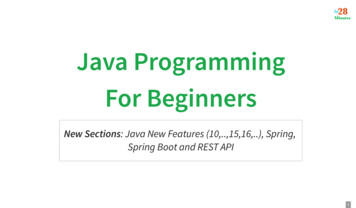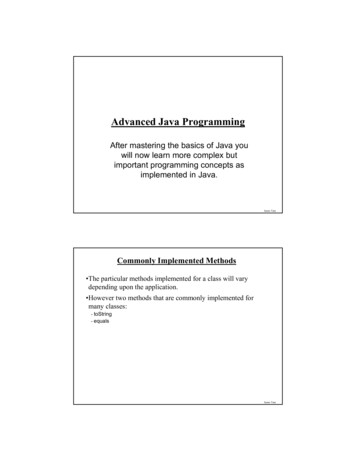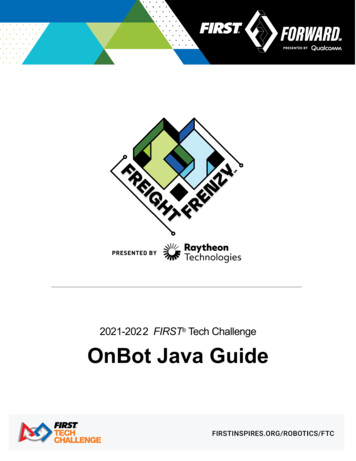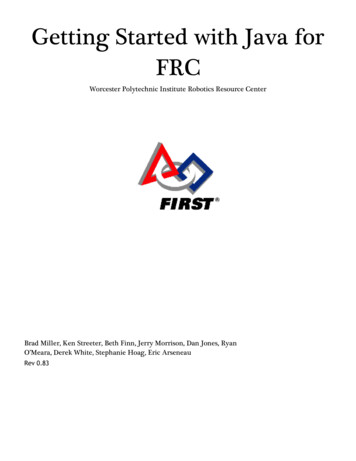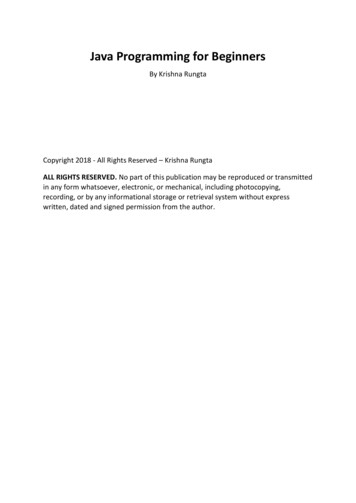
Transcription
Extracted from:Functional Programming in JavaHarnessing the Power of Java 8 Lambda ExpressionsThis PDF file contains pages extracted from Functional Programming in Java,published by the Pragmatic Bookshelf. For more information or to purchase apaperback or PDF copy, please visit http://www.pragprog.com.Note: This extract contains some colored text (particularly in code listing). Thisis available only in online versions of the books. The printed versions are blackand white. Pagination might vary between the online and printed versions; thecontent is otherwise identical.Copyright 2014 The Pragmatic Programmers, LLC.All rights reserved.No part of this publication may be reproduced, stored in a retrieval system, or transmitted,in any form, or by any means, electronic, mechanical, photocopying, recording, or otherwise,without the prior consent of the publisher.The Pragmatic BookshelfDallas, Texas Raleigh, North Carolina
Many of the designations used by manufacturers and sellers to distinguish their productsare claimed as trademarks. Where those designations appear in this book, and The PragmaticProgrammers, LLC was aware of a trademark claim, the designations have been printed ininitial capital letters or in all capitals. The Pragmatic Starter Kit, The Pragmatic Programmer,Pragmatic Programming, Pragmatic Bookshelf, PragProg and the linking g device are trademarks of The Pragmatic Programmers, LLC.Every precaution was taken in the preparation of this book. However, the publisher assumesno responsibility for errors or omissions, or for damages that may result from the use ofinformation (including program listings) contained herein.Our Pragmatic courses, workshops, and other products can help you and your team createbetter software and have more fun. For more information, as well as the latest Pragmatictitles, please visit us at http://pragprog.com.Sir Charles Antony Richard Hoare’s quote is used by permission of the ACM.Abelson and Sussman’s quote is used under Creative Commons license.The team that produced this book includes:Jacquelyn Carter (editor)Potomac Indexing, LLC (indexer)Candace Cunningham (copyeditor)David J Kelly (typesetter)Janet Furlow (producer)Ellie Callahan (support)For international rights, please contact rights@pragprog.com.Copyright 2014 The Pragmatic Programmers, LLC.All rights reserved.No part of this publication may be reproduced, stored in a retrieval system, ortransmitted, in any form, or by any means, electronic, mechanical, photocopying,recording, or otherwise, without the prior consent of the publisher.Printed in the United States of America.ISBN-13: 978-1-937785-46-8Encoded using the finest acid-free high-entropy binary digits.Book version: P1.0—February 2014
To the loving memory of my grandmothers,Kuppammal and Jayalakshmi. I cherish mywonder years under your care.
There are two ways of constructing a software design: One way is tomake it so simple that there are obviously no deficiencies, and theother way is to make it so complicated that there are no obviousdeficiencies. The first method is far more difficult.1 Sir Charles Antony Richard HoareCHAPTER 1Hello, Lambda Expressions!Our Java coding style is ready for a remarkable makeover.The everyday tasks we perform just got simpler, easier, and more expressive.The new way of programming in Java has been around for decades in otherlanguages. With these facilities in Java we can write concise, elegant, andexpressive code with fewer errors. We can use this to easily enforce policiesand implement common design patterns with fewer lines of code.In this book we’ll explore the functional style of programming using directexamples of everyday tasks we do as programmers. Before we take the leapto this elegant style, and this new way to design and program, let’s discusswhy it’s better.Change the Way You ThinkImperative style—that’s what Java has provided us since its inception. In thisstyle, we tell Java every step of what we want it to do and then we watch itfaithfully exercise those steps. That’s worked fine, but it’s a bit low level. Thecode tends to get verbose, and we often wish the language were a tad moreintelligent; we could then tell it—declaratively—what we want rather thandelve into how to do it. Thankfully, Java can now help us do that. Let’s lookat a few examples to see the benefits and the differences in style.The Habitual WayLet’s start on familiar ground to see the two paradigms in action. Here’s animperative way to find if Chicago is in a collection of given cities—remember, the1.Hoare, Charles Antony Richard, "The Emperor’s Old Clothes," Communications of theACM 24, no. 2 (February 1981): 5–83, doi:10.1145/358549.358561. Click HERE to purchase this book now. discuss
2listings in this book only have snippets of code (see How to Read the CodeExamples, on page ?).introduction/fpij/Cities.javaboolean found false;for(String city : cities) {if(city.equals("Chicago")) {found true;break;}}System.out.println("Found chicago?:" found);This imperative version is noisy and low level; it has several moving parts.We first initialize a smelly boolean flag named found and then walk through eachelement in the collection. If we found the city we’re looking for, then we setthe flag and break out of the loop. Finally we print out the result of our finding.A Better WayAs observant Java programmers, the minute we set our eyes on this codewe’d quickly turn it into something more concise and easier to read, like ln("Found chicago?:" cities.contains("Chicago"));That’s one example of declarative style—the contains() method helped us getdirectly to our business.Tangible ImprovementsThat change improved our code in quite a few ways: No messing around with mutable variablesIteration steps wrapped under the hoodLess clutterBetter clarity; retains our focusLess impedance; code closely trails the business intentLess error proneEasier to understand and maintainBeyond Simple CasesThat was simple—the declarative function to check if an element is presentin a collection has been around in Java for a very long time. Now imagine nothaving to write imperative code for more advanced operations, like parsing Click HERE to purchase this book now. discuss
Change the Way You Think 3files, working with databases, making calls to web services, programmingconcurrency, and so on. Java now makes it possible to write concise, elegant,less error-prone code, not just for simple cases, but throughout ourapplications.The Old WayLet’s look at another example. We’ll define a collection of prices and try outa few ways to total discounted price values.finalnewnewnewList BigDecimal prices Arrays.asList(BigDecimal("10"), new BigDecimal("30"), new BigDecimal("17"),BigDecimal("20"), new BigDecimal("15"), new BigDecimal("18"),BigDecimal("45"), new BigDecimal("12"));Suppose we’re asked to total the prices greater than 20, discounted by 10%.Let’s do that in the habitual Java way Decimal totalOfDiscountedPrices BigDecimal.ZERO;for(BigDecimal price : prices) {if(price.compareTo(BigDecimal.valueOf(20)) 0)totalOfDiscountedPrices mal.valueOf(0.9)));}System.out.println("Total of discounted prices: " totalOfDiscountedPrices);That’s familiar code; we start with a mutable variable to hold the total of thediscounted prices. We then loop through the prices, pick each price greaterthan 20, compute each item’s discounted value, and add those to the total.Finally we print the total value of the discounted prices.And here’s the output from the code.Total of discounted prices: 67.5It worked, but writing it feels dirty. It’s no fault of ours; we had to use whatwas available. But the code is fairly low level—it suffers from “primitiveobsession” and defies the single-responsibility principle. Those of us workingfrom home have to keep this code away from the eyes of kids aspiring to beprogrammers, for they may be dismayed and sigh, “That’s what you do for aliving?”A Better Way, AgainNow we can do better—a lot better. Our code can resemble the requirementspecification. This will help reduce the gap between the business needs and Click HERE to purchase this book now. discuss
4the code that implements it, further reducing the chances of the requirementsbeing misinterpreted.Rather than tell Java to create a mutable variable and then to repeatedlyassign to it, let’s talk with it at a higher level of abstraction, as in the final BigDecimal totalOfDiscountedPrices prices.stream().filter(price - price.compareTo(BigDecimal.valueOf(20)) 0).map(price - gDecimal.ZERO, BigDecimal::add);System.out.println("Total of discounted prices: " totalOfDiscountedPrices);Let’s read that aloud—filter prices greater than 20, map the prices to discounted values, and then add them up. The code flows along with logic in thesame way we’d describe the requirements. As a convention in Java, we wraplong lines of code and line up the dots before the method names, as in theprevious example.The code is concise, but we’re using quite a number of new things from Java8. First, we invoked a stream() method on the prices list. This opens the door toa special iterator with a wealth of convenience functions, which we’ll discusslater.Instead of explicitly iterating through the prices list, we’re using a few specialmethods, such as filter() and map(). Unlike the methods we’re used to in Javaand the Java Development Kit (JDK), these methods take an anonymousfunction—a lambda expression—as a parameter, within the parentheses ().(We’ll soon explore this further.) We invoke the reduce() method to computethe total on the result of the map() method.The looping is concealed much like it was under the contains() method. Themap() method (and the filter() method), however, is more sophisticated. For eachprice in the prices list, it invokes the provided lambda expression and puts theresponses from these calls into a new collection. The reduce() method is invokedon this collection to get the final result.Here’s the output from this version of code:Total of discounted prices: 67.5The ImprovementsThis is quite an improvement from the habitual way: Click HERE to purchase this book now. discuss
Change the Way You Think 5Nicely composed, not clutteredFree of low-level operationsEasier to enhance or change the logicIteration controlled by a library of methodsEfficient; lazy evaluation of loopsEasier to parallelize where desiredLater we’ll discuss how Java provides these improvements.Lambdas to the RescueLambdas are the functional key to free us from the hassles of imperativeprogramming. By changing the way we program, with a feature now bakedinto Java, we can write code that’s not only elegant and concise, but also lessprone to errors; more efficient; and easier to optimize, enhance, and parallelize. Click HERE to purchase this book now. discuss
Our Java coding style is ready for a remarkable makeover. The everyday tasks we perform just got simpler, easier, and more expressive. The new way of programming in Java has been around for decades in other languages. With these facilities in Java we can write
